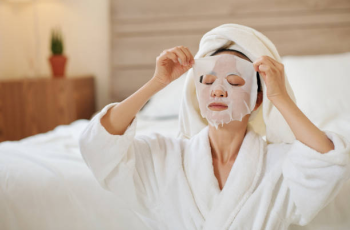
7 Nonsurgical Treatments to Tighten Loose Skin, Recommended by Dermatologists
No one needs to treat sagging skin, but experts say these procedures are worth it if you’re ready.
Two years into the pandemic that has brought the world to a standstill, I’m looking forward to attending in-person social events again. I’ve also learned that I can’t bring my social media filters and Facetune to real-life events.
That’s not really what I want—our faces reveal our origins, our personalities, our happiness, and our life experiences. But I like to adapt, especially when my skin is sagging.
As a child, my angelic face turned oval as puberty arrived. But I loved the defined jawlines and high cheekbones I see on Hollywood stars and Instagram. Starting at age 35, I also noticed that my face began to lose volume.
My skin began to sag, which doctors said was due to rapid weight loss and the natural effects of time and environmental factors. So I was looking for ways to tighten my skin. I was willing to try anything that could improve my sagging skin.
Initially, I tried chemical peels (e.g., alpha and beta hydroxy acids), which improved skin texture but didn’t cause the sagging skin I was worried about. But now for the bad news:
“Topical medications will never cure sagging skin,” says Dr. Paul Jarrod Frank, a practicing dermatologist in New York City and author of The Anti-Aging Handbook (by Paul Jarrod Frank). If I want to combat sagging skin, I have to rely on injections.
Fortunately, I have access to a team of experienced dermatologists who can tell me more about the various nonsurgical methods of treating sagging skin.
What causes sagging skin?
By understanding the causes of skin volume loss, you can combat sagging skin and proactively prevent it. In short, Dr. Lara Devgan, a board-certified cosmetic plastic surgeon in New York City, explains, “Sagging skin with aging is caused by the gradual loss of collagen and elastin.”
These two naturally occurring proteins are abundant in our tissues but disappear as we age. “Collagen supports and structures tissues, while elastin provides elasticity, resilience, and stretch,” says Dr. Devgan.
“Collagen and elastin are important to skin quality because together they make the skin plumper and smoother, and make the skin look and feel stronger and healthier.” Over time, our cellular proteins begin to break down due to genetic predisposition or sun exposure and other factors, such as UVA and UVB radiation.
There are ways to counteract the effects of these factors, such as wearing sunscreen daily and eating certain foods—Dr. Devgan recommends “a diet rich in biotin, folate, B vitamins, lean protein, and micro- and macronutrients.”
However, there are some factors you can’t control. “Ethnicity also determines how early or late the signs of aging appear: Skin with less melanin is more likely to show signs of aging sooner,” explains Dr. Rosemary Ingleton, a dermatologist in New York City and assistant clinical professor of dermatology at Mount Sinai Hospital.
What are some nonsurgical methods for treating loose skin?
Many of the experts I spoke with said that the effectiveness of minimally invasive treatments for loose skin is still being tested. “Nonsurgical treatments for loose skin remain a black box in plastic surgery,” Dr. Devgan says.
She adds that while there has been extensive research on the subject, “we don’t have a perfect answer to the question of how effective nonsurgical skin tightening is yet. Many companies and research institutions are actively working on the subject, but we haven’t found the perfect treatment yet.
So there’s no magic formula.” Still, Dr. Devgan says she thinks some approaches hold promise. Frank says he often uses a combination of treatments to treat deep and surface tissues and address general skin laxity.
Experts have identified several nonsurgical methods for treating skin laxity that should be considered and discussed with a qualified physician to find the right one for your skin.
Radiofrequency (RF) Skin Tightening and Ultrasound
Radiofrequency (RF) skin tightening treatments involve sending radio waves under the skin to stimulate the production of collagen and elastin, according to Dr. Devgan. In addition to RF skin tightening, ultrasound is another method worth considering because it can achieve similar results, says Dr. Roy Geronemus, director of the New York Center for Laser and Skin Surgery and clinical professor of dermatology at New York University Medical Center.
I always associate ultrasound with the diagnostic devices used during pregnancy to monitor fetal development or the wands that radiologists use to detect kidney stones. However, the process of skin tightening is slightly different.
In ultrasound skin treatments, a concentrated beam of energy from an ultrasound device is directed at a target area, heating the dermis and stimulating collagen production.
RF skin tightening treatments start at about $250 per session, depending on the size of the treatment area.
Injectable fillers
Dr. Ingleton reports that patient interest in fillers is increasing. “For two years, people have been looking at photos of themselves on Zoom meetings and noticing all kinds of age-related changes in their faces,” she says.
“They are increasingly turning to fillers and Botox to look better in front of the camera and in their daily lives.”
Dr. Ingleton adds that hyaluronic acid fillers such as Juvéderm and Restylane can help compensate for collagen loss. “Some hyaluronic acid products can not only restore volume, but also tighten sagging facial areas, depending on the product used and the doctor’s injection technique,” ??she says.
Dr. Ingleton. Devgan also mentioned the potential benefits of fillers, “improving the bone structure of an aging face, supporting sagging tissue, and creating a more aesthetically pleasing facial shape.”
Voluma is a hyaluronic acid filler that is approved by the U.S. Food and Drug Administration (FDA) for use in the cheek area.
This is nothing new to me—I’ve been using it to enhance my cheekbones for years. Like many nonsurgical procedures, fillers need to be reapplied from time to time to achieve the desired results. Most experts say how often varies from person to person, but once every six months is a good rule of thumb.
Fillers start at around $900 for a 1-mL syringe, Dr. Ingleton explained, but prices can vary depending on the amount and type of filler used.
Microneedling
Dr. Ingleton believes nonsurgical treatments can actually help reduce the appearance of sagging skin, and points to microneedling as a treatment that can be effective. Microneedling is a treatment that uses very fine needles to make micropunctures in the skin to stimulate collagen production.
According to Dr. Ingleton, a combination of microneedling and radiofrequency can achieve effective skin tightening results.
“Microneedling RF devices like the EndyMed Intensif puncture tiny holes in the skin and deliver RF heat deep into the skin, tightening it over time,” she explains. However, Ingleton notes that special precautions must be taken when using RF microneedling on dark skin, as those with higher melanin content are more likely to experience hyperpigmentation.
Regardless of skin tone, Dr. Frank recommends avoiding direct sunlight for several weeks after microneedling or other treatments that may cause inflammation.
Microneedling treatments cost about $300 per session.
Micro-coring
For those who like to stay up to date: Dr. Geronemus describes micro-coring as “a new method that is currently being introduced that can tighten the skin.” According to Practical Dermatology, skin micro-coring uses non-electro-acupuncture needles to create tiny holes in the skin. The needles are guided through a grid.
Micro-coring is a very thin needle, so it is usually painless. The procedure removes only a small amount of the epidermis and leaves no scars. This causes the skin to shrink and tighten while stimulating the production of collagen and elastin.
A micro-coring drill called the Ellacor was launched last year after receiving FDA approval. Dr. Geronemus says it costs $2,000 to $3,000 per treatment, noting that multiple treatments are usually required.
Lasers
The experts I spoke with confirmed that laser resurfacing is a beneficial skin treatment, although they don’t all agree that it helps tighten the skin. Lasers — short for stimulated amplification of emitted radiation — use small, focused beams of light to stimulate collagen production.
For those who advocate laser skin tightening, Dr. Devgan says erbium lasers can “tighten the skin envelope.” The erbium laser beam is absorbed by the water in the skin and vaporizes the skin tissue. The heat from the laser stimulates collagen production, which tightens the skin.
While Dr. Frank acknowledges the advantages of lasers over other skin enhancement treatments, he remains skeptical of their skin-tightening effects: “Laser is best for removing sun damage, broken capillaries, and melasma, but it doesn’t necessarily tighten the skin,” he says. “However, removing sun damage can improve the overall quality and texture of the skin.”
Laser treatments vary greatly depending on the type of laser used and the size of the area treated. Treatments typically start at $750 per session for the Fraxel laser and $500 per session for the Clear + Brilliant laser.
Thread Lift
In my early thirties, I noticed that the skin around my eyes and jawline was losing elasticity. I looked tired and my jawline felt weak. Finally, I tried thread lifts under the guidance of Dr. Devgan, who describes it as “modern thread lifts.” The technique involves lifting and resuspending loose or sagging tissue and is often used to tighten the cheek or brow area.
During the procedure, several small incisions are made and internal sutures are placed to sculpt the face. Sounds painful, right? Don’t worry, it wasn’t for me. Because according to Dr. Devgan, “the sutures are inserted through a small needle puncture, so there is no cutting.”
And it’s quick, too. “It causes the same downtime and discomfort as injectable fillers,” Dr. Devgan adds. “The procedure is performed in the office, takes about 15 minutes, and patients can return to their normal appearance within an hour.”
What is the pain level and recovery time for each treatment? Dr. Frank tells Allure that for most patients with the recommended method, recovery time and pain level should be very short. Pain level and treatment duration are subjective, but Dr. Frank adds that both factors are “related to the dose of anesthesia and the intensity of the treatment.” In theory, the deeper the needle or suture is inserted, the more intense the pain and the longer the rest period will be.
“The key is that nothing is unbearable—a 5 or 6 on a 10-point pain scale at best,” Dr. Frank adds. The experts I spoke with say that post-procedure recovery time for nonsurgical treatments is minimal, ranging from looking and feeling normal within the same day to a week.
“Injectable fillers, radiofrequency, and suture suspension minimize downtime, and patients seem to be able to return to work or other activities soon after the procedure,” Dr. Devgan says. Bruising and swelling are always possible, but can be quickly covered with makeup. Lasers cause varying degrees of redness, depending on the energy setting.
Dr. Geronemus adds that most patients who choose micropiercing have a recovery time of about three days.
Which treatment is right for me?
One thing is clear: Everyone deserves to care for or maintain their skin the way they want to. No one needs to spend the time or money to treat skin laxity, but there are other options if you want to. Only you and a licensed professional can find the right path.
“Some treatments vary greatly depending on the patient’s needs and concerns. Because the extent of treatment can vary greatly, individualized counseling is necessary,” Dr. Devgan said.
When speaking with a physician, Dr. Geronemus evaluates whether the procedure was ordered or performed by the physician based on his experience with the procedure and whether the device the physician is using is best suited for the specific clinical need.

